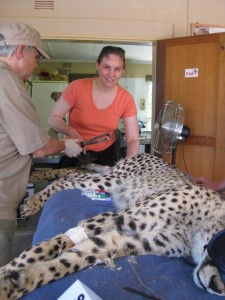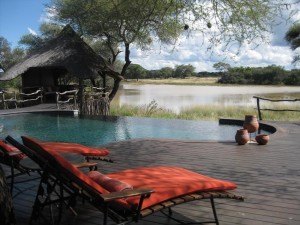World's Largest Cheetah and Leopard Rescue Release Program

Assistant Editor's note: ATTA's Vice President of Business Development, Chris Chesak, and Member Advocate Alice Gifford are in Namibia this week, participating on an educational trip with ATTA Members represented in the Naturally Namibia family of safari lodge and conservation projects.
Here is Alice's recent report from the field:
As I've learned in our first full day in Namibia, Okonjima Lodge, has been leading the way in predator conservation since 1993 with the onsite family-owned and run AfriCat Foundation. With funding coming directly from overnight guest fees, donations and private support, the Hanssen family, AfriCat staff, volunteers and guests have saved more than 1,000 carnivores over the last 18 years (primarily cheetahs and leopards, as well as lion, caracal, wild dogs and hyena). Even though Cheetahs remain on the CITES endangered species list (less than 10,000 worldwide population), AfriCat has an extremely high rate of successful rehabilitated releases into the wild (86%), and with the international acclaim of a 1995-96 Discovery Channel documentary (and upcoming ITV Cheetah Kingdom series), the foundation and Okonjima have been able to put more focus on their ultimate goal: to return 22,000 hectacres (and more) of land back to its original ecosystem.
The day I arrived, there were about 20 people at the small open air clinic, waiting for 4 tranquilized young cheetahs. When they arrived, they were given a full veterinarian checkup, and what the P.A.W.S. and Steppes Travel volunteers referred to as their "spa treatment" - picking burrs from their fur (Cheetahs do not groom themselves, like other big cats), brushing, and clipping nails, all while under sedation and open eyes covered with sleeping masks (the mask you might find on an Air Namibia flight!). They must work quickly and monitor each cat's vitals so that a high level of stress is avoided - the cats are sedated but conscious. Within minutes, I snapped a few photos but was quickly asked to help remove burrs from a 2-year old male cheetah's tail. His name was Starsky (his brother, Hutch was attacked by a leopard after jumping a protective fence when he was a cub - a sad but important lesson for his other siblings).

Most of the cats and other predators come from the 7,000 commercial livestock farms throughout Namibia. When cattle graze unprotected, carnivores will occasionally prey upon them, and as a result, they are treated like pests by farmers (trapped or killed). Often times, those who are killed have orphaned babies - the cubs are brought to AfriCat. In general, predator removal is a method of conflict mitigation. Not only does Okanjima provide a home, food, care and an environment for previously non-releasable carnivores to hone their hunting skills, AfriCat provides education programs for Namibia's youth and critical research for scientists and authorities while working diligently to create effective farm-management techniques, livestock protection and outreach with farmers to become more predator-tolerant.
At Okonjima (whose name in the Herero language means "place of the Baboons"), guests and volunteer travelers come mainly from Europe, en route to the more famous Etosha National Park. From students to adults; overnight, weeklong or up to 3 months in duration, they come in part to experience the Waterberg National Park plateau, and to rehabilitate the once-overrun cattle farmland to its natural Acacia forest and grassland. Activities and projects include daily tracking (on foot and in game drive vehicles) and caring for the animals in the reserve: cheetahs, leopards, impala, kuru, wild boars, zebra, more than 200 bird species... and more hands-on tasks such as dismantling windmills and old water troughs, claring fences, bone collecting, and, if the timing is right, give a sleepy cheetah a "spa treatment".
As the literature I received on my bedside table proclaims, 1,000 cheetahs and leopards have been saved in 18 years. 875 of those have been successfully rehabilitated and relocated into the wild. The statistics speak for themselves, but AfriCat is able to continue this critical work thanks to the ongoing support of the travel industry.
